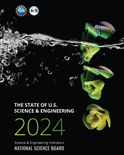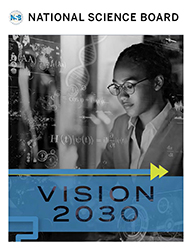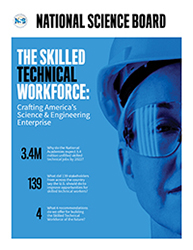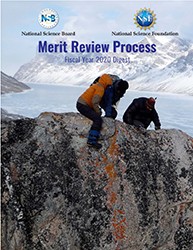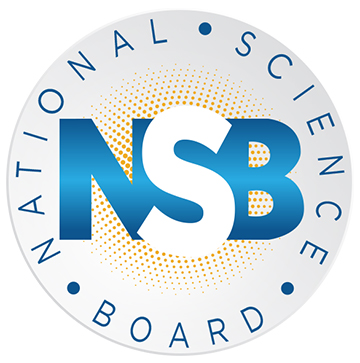
The U.S. Must Invest in its People to Lead Discoveries and Innovations
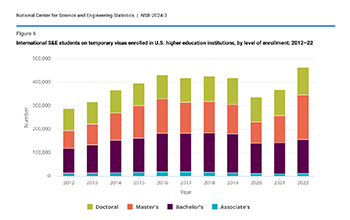
International S&E students on temporary visas enrolled in U.S. higher education institutes (Credit and Larger Version)
March 13, 2024
Today the National Science Board published The State of U.S. Science and Engineering 2024, which shows that although the United States performs more research and development than any other country, the nation’s global position is slipping, as countries in East and Southeast Asia, particularly China, increase their activities.
“The Indicators report confirms that our nation’s science and engineering (S&E) enterprise increasingly hinges on foreign-born STEM talent and is limited by flat federal R&D investment, all at a time when global innovation continues to accelerate,” said Daniel Reed, Chair of the National Science Board and Presidential Professor of Computational Science at the University of Utah. “Meanwhile, other countries are heavily investing in their own S&E talent development, next-generation research infrastructure, and the advanced technology areas critical to national defense and global economic competitiveness.”
The science, technology, engineering, and mathematics workforce drives U.S. innovation, which is the linchpin of the nation’s economic and national security. The nation must take action to grow and support domestic talent that is currently left on the sidelines.
“The nation must take action to grow and support domestic talent that is currently left on the sidelines.”
“We must use policies, like a new National Defense and Education Act, and appropriate robust funding to federal science agencies, including through the CHIPS and Science Act, to ensure that our nation does not continue to lose ground to others,” Reed said.
The report shows the outsized role that foreign-born scientists and engineers play in U.S. competitiveness, especially at the doctoral level. It also reveals how the COVID-19 pandemic disrupted S&E education and research, and negatively impacted mathematics scores for American elementary and secondary students.
The comprehensive report demonstrates that the U.S. no longer predominates across all elements of science, technology, and innovation. Instead, the nation is distinguished by the strength of its universities as destinations for international students, its highly cited and collaborative research, and its leadership in knowledge and technology intensive services, which include information technology and other information services, scientific R&D services, and software publishing.
“This report shows the tremendous strength of American research and development, which is the most powerful innovation engine in history” said Arati Prabhakar, Assistant to the President for Science and Technology and Director of the White House Office of Science and Technology. “President Biden often says that America can be defined in one word: possibilities. Together, public and private R&D investments are opening new possibilities so we can achieve our nation’s great aspirations.”
“The United States has long led the pursuit of revolutionary science and impactful innovation,” said Sethuraman Panchanathan, Director of the U.S. National Science Foundation. “With each Indicators report, we witness new insights and shifting trends from within the nation and beyond our borders. However, this latest report delivers an urgent message: For the U.S. to maintain leadership in science and technology, and the societal and economic impacts that result, we must invest in and accelerate our commitment to STEM and ensure that we unleash our superpower—the collective experiences and motivations from individuals across our entire nation—to the benefit of all.”
“It is time to act, with vision and commitment, by expanding our domestic STEM worker pool, investing in critical science and technology areas, and building the necessary research and development infrastructure to ensure our continued national security and economic independence. The job is not done, and we neglect it at our peril,” Reed said.
Other highlights
Research and Development: The United States is the largest performer of R&D, with $806 billion in gross domestic expenditures on R&D in 2021. Other top R&D- performing countries include China ($668 billion), Japan ($177 billion), Germany ($154 billion), and South Korea ($120 billion). The United States is also among the world’s most R&D-intensive economies, with R&D expenditures equaling 3.5% of its gross domestic product in 2021.
Publications: Globally, six countries combined produced more than 50% of the worldwide peer-reviewed S&E publications in 2022: China (27%), the United States (14%), India (6%), Germany (3%), the United Kingdom (3%), and Japan (3%). From 2003 to 2022, annual S&E publications increased by roughly a third (36%) in the United States, whereas they increased approximately 10-fold in China and 8-fold in India.
Open Access: Open-access publications provide free access to peer-reviewed scientific literature without requiring user fees or journal subscriptions. S&E articles published in open-access journals increased over 50-fold in the past two decades, from 19,000 articles published in 2003 to 992,000 articles in 2022.
Elementary and Secondary Education: From 2020 to 2023, the average score on a national mathematics assessment for all 13-year-old students dropped by 9 points. Scores for students in the 10th percentile — those scoring near the low end of all assessment takers — dropped by 14 points, whereas scores for students in the 90th percentile dropped by 6 points. As a result, the gap between students scoring in the 10th percentile (213) and the 90th percentile (322) widened to 109 points, the largest it has been since the assessment began in 1978.
STEM Workforce: In 2021, the U.S. STEM workforce comprised 36.8 million people in diverse occupations that require STEM knowledge and expertise, accounting for 24% of the total U.S. workforce. Just over half of STEM workers, or 19.3 million workers, are part of the skilled technical workforce, which means they do not have bachelor’s degrees or higher. Foreign-born individuals made up 19% of all U.S. STEM workers and 43% of doctoral-level scientists and engineers.
Knowledge- and Technology-Intensive (KTI) Industries: The U.S. is the largest provider of KTI services, with $1.3 trillion in value-added output in 2021. KTI industries are those classified by the Organisation for Economic Co-operation and Development as high R&D intensive and medium-high R&D intensive industries based on R&D intensity. U.S. KTI services’ output more than doubled from 2012 to 2021, increasing the U.S. share of global KTI services from 30% in 2012 to 39% in 2021, nearly twice the EU-27’s share (21%) of global KTI services in 2021.
Invention and Innovation: Inventors based in China surpassed those based in the U.S. for international total patent applications for the first time in 2021. Patents issued by the Patent and Trademark Office (USPTO) focus on inventions, both foreign and domestic, that are granted exclusive use rights in the U.S. market. Of the 325,000 USPTO utility patents granted in 2022, a total of 142,000 (44%) were granted to U.S. inventors. Foreign inventors’ share of patents increased from 52% in 2012 to 56% in 2022.
Public Perceptions: Americans’ degree of trust in scientists has remained high for decades, although it varies by level of education and has fluctuated in recent years. In 2022, 77% of adults in the United States expressed either “a great deal” or “a fair amount” of confidence in scientists to act in the best interests of the public.
About Science and Engineering Indicators
Science and Engineering Indicators is a congressionally mandated report on the state of the U.S. and international science and engineering enterprise. Indicators provides high-quality quantitative information on the enterprise in a series of reports and a data tool that provides state-level data.
About the NSB
The National Science Foundation Act of 1950 charged the NSB with two roles: to be the governing board of the NSF and an advisor to Congress and the President on policy matters related to STEM research and STEM education. Selected for their distinguished service and accomplishments in academia, government, and the private sector, the Board’s 24 presidentially appointed members are leaders in STEM research and education.
About the NCSES
NSF’s National Center for Science and Engineering Statistics (NCSES) is the nation's leading provider of statistical data on the U.S. science and engineering enterprise. As a principal federal statistical agency, NCSES serves as a clearinghouse for the collection, interpretation, analysis, and dissemination of objective science and engineering data.
Media Contact: Elizabeth Jeffers, ejeffers@nsf.gov
Useful NSB Web Sites:
Home Page: http://www.nsf.gov/nsb
Media Contact: http://www.nsf.gov/staff/staff_bio.jsp?lan=nlymn&org=NSF
News: http://www.nsf.gov/nsb/news
Meetings: http://www.nsf.gov/nsb/meetings
Publications: http://www.nsf.gov/nsb/publications
Facebook: https://www.facebook.com/NationalScienceBoard
Twitter: Twitter: https://twitter.com/intent/user?screen_name=NSF_NSB
YouTube: https://www.youtube.com/channel/UCkrHRzuGSrPp2haQs0T_Pww
To view PDF documents, please download Adobe Acrobat Reader.
